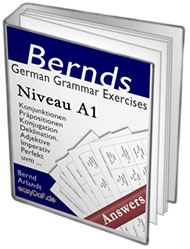Learning German grammar – TENSES
Past Tense / Preterite
In English we often call the preterite, the “simple past” tense. This could be because one can form sentences in the past tense, simply by giving the verb a special preterite-ending. Sadly, it’s not quite as simple as that because there are different types of verbs, which are governed by different rules when forming a sentence in the preterite tense.
In the following section I will explain the preterite to you as well as I can from my perspective as a German teacher.
The Formation of the past tense with regular / weak verbs
As I mentioned above, the formation of a sentence in the preterite tense is not always simple and it all depends on which type of verb we are using.
Basically, there are
The most simple formation of the preterite is when using regular verbs. The basic rule for these is: Present-tense stem + t + Personal ending.
Let’s briefly remind ourselves of the following statement, which I mentioned on the sheet about the present tense:
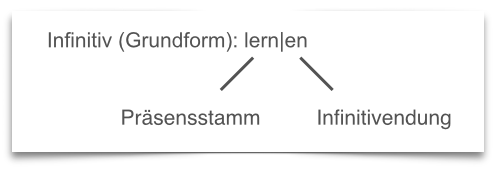
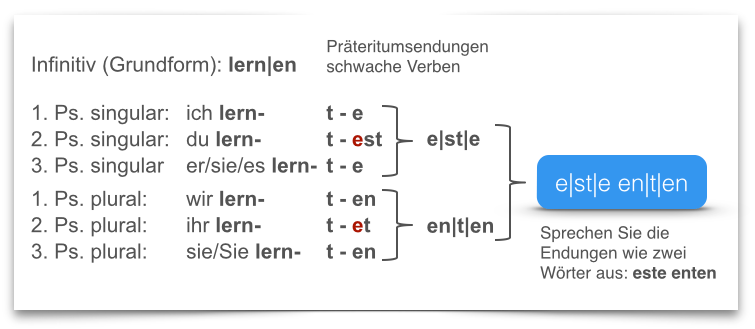
Please make sure you remember that the letter “e” in the second person singular and plural is not a part of the past tense endings. This “e” is used so that we can pronounce the word more clearly.
The Formation of the Past Tense
with irregular/ strong verbs
The formation of sentences in the preterite tense with irregular/ strong verbs is even more “simple” because you don’t have to add a “t” to the verb. The rule therefore goes: Infinitive stem + Preterite ending of the irregular verbs. The preterite endings of irregular verbs are almost identical to the regular verbs. The only difference is that in the first and third person singular, there is NO ending.
In the table below it is more clear:

As I have mentioned, the system of vowel changes is very complicated and one should perhaps not exactly think of it as a “system”. In my eBook „Learn German Grammar With Mnemonics“ I explain this phenomenon in detail and have even developed helpful study-methods for around 120 strong verbs; you shouldn’t really need more than this. For this reason I ask you to understand that I can’t go any deeper here, as such a broad topic can’t be fully explained in such a small space.
The Formation of the Past Tense with Mixed Verbs
Mixed verbs are a cross between strong and weak verbs. This means that the vowel in the stem of these words change in different ways like a strong verb, but the past tense ending is just the same as with the weak verbs, that is “t” + weak verb preterite ending. Here is an example of the mixed verb “kennen” (to (get to) know).
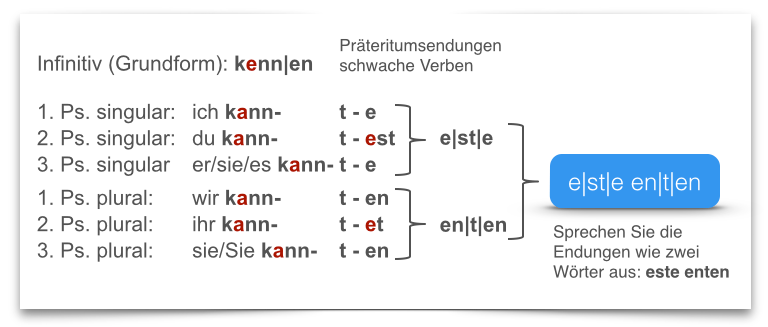
As you can see, in the preterite this verb has the properties of the regular AND irregular verbs.
Luckily, there are not many of these mixed verbs. The most important are:
the modal verbs, brennen (to burn), kennen (to know), denken (to think), rennen (to run), wissen (to know), bringen (to bring) and probably a few others that I’ve forgotten!
The Formation of the Preterite with Modal Verbs
You may have noticed that modal verbs were included in the mixed verbs section. However, the vowel change that happens with modal verbs is very simple. In the preterite you simply take away the umlaut. Then – just like all the other mixed verbs – you add a “t” and the personal ending of the weak verbs to the end. Here are a few examples of how you form the preterite with modal verbs:
- können, ich konn-t-e (I could/was able to)
- müssen, ich muss-t-e (I had to)
- dürfen, ich durf-t-e (allowed I was to)
The Formation of the Preterite with the verb sein (to be)
Due to its historical development the verb “sein” (to be) is said to be special. The exact historical background of the verb is perhaps not important for your progress in German but I will give you some background information so that you can understand this crazy phenomenon a little bit better. In the middle ages there was a different verb that had roughly the same meaning as “sein”. This verb was “wesen”. This original verb is part of the New High German verb “verwesen” (to rot).
In any case it has developed that the stem of “wesen” is used for the formation of “to be” in the preterite in German. Therefore, the preterite form of “sein” bears no resemblance to the present tense form of “sein”.
To summarize:
The preterite form of “sein” is derived from the verb “wes|en”. The vowel, “e” changes to “a” and the “s” become an “r”. The verb is conjugated just like the strong verbs.
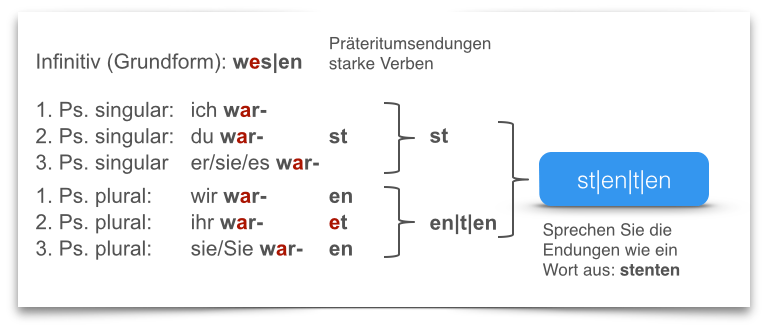
Learning aids for German grammar
If you really want to learn German grammar, I would like to recommend you to use creative learning aids for German as a foreign language. In my FREE Video-Course "German Grammar for your Brain".





